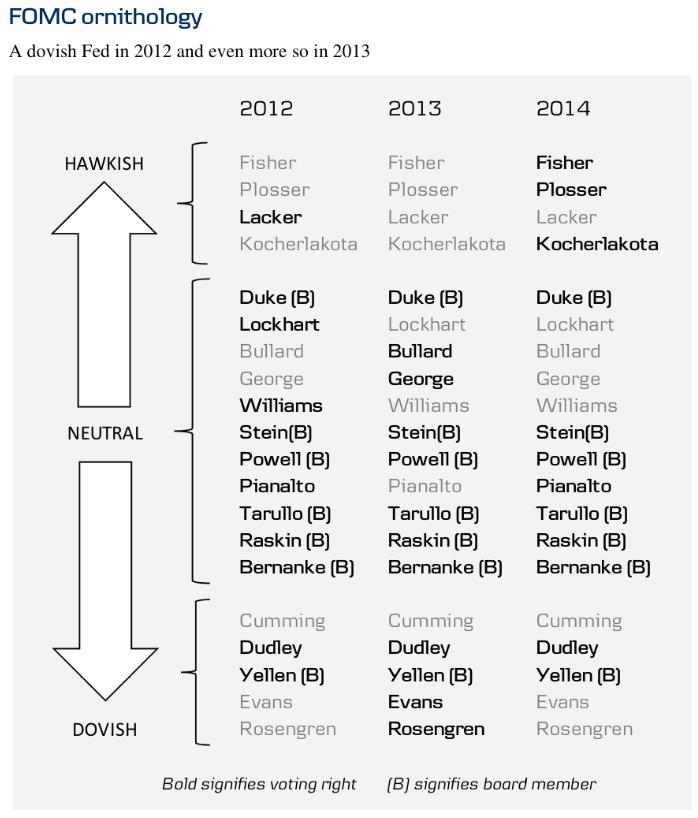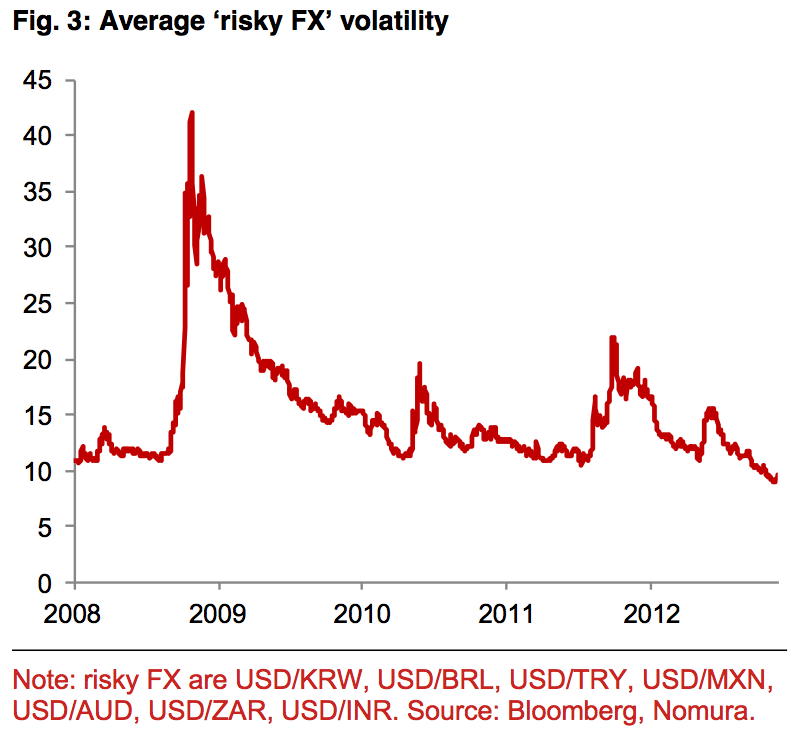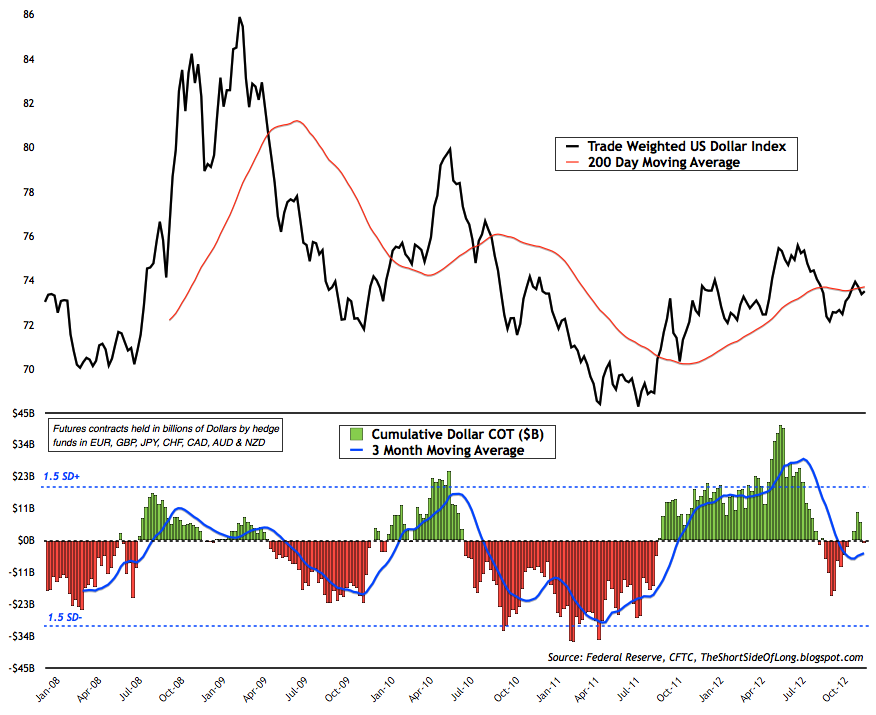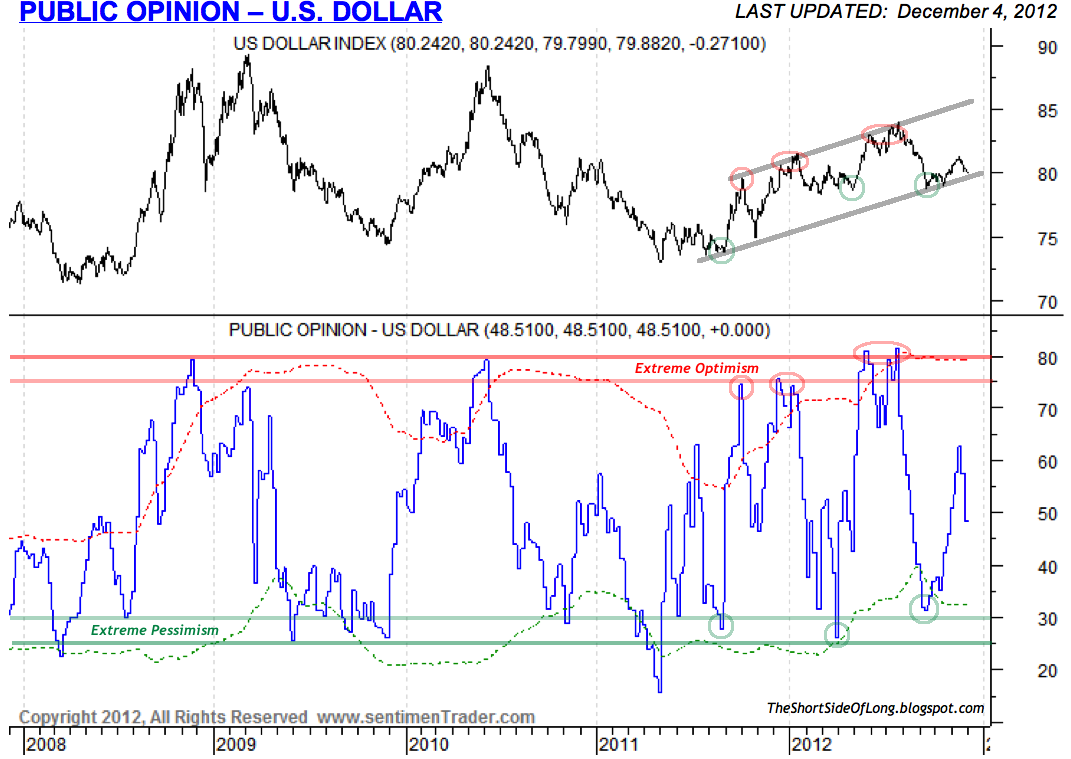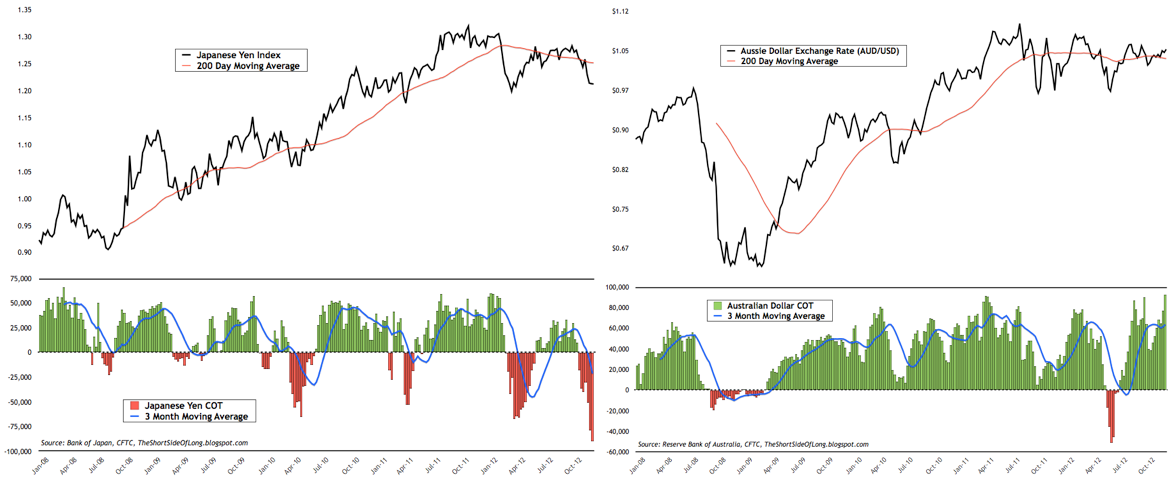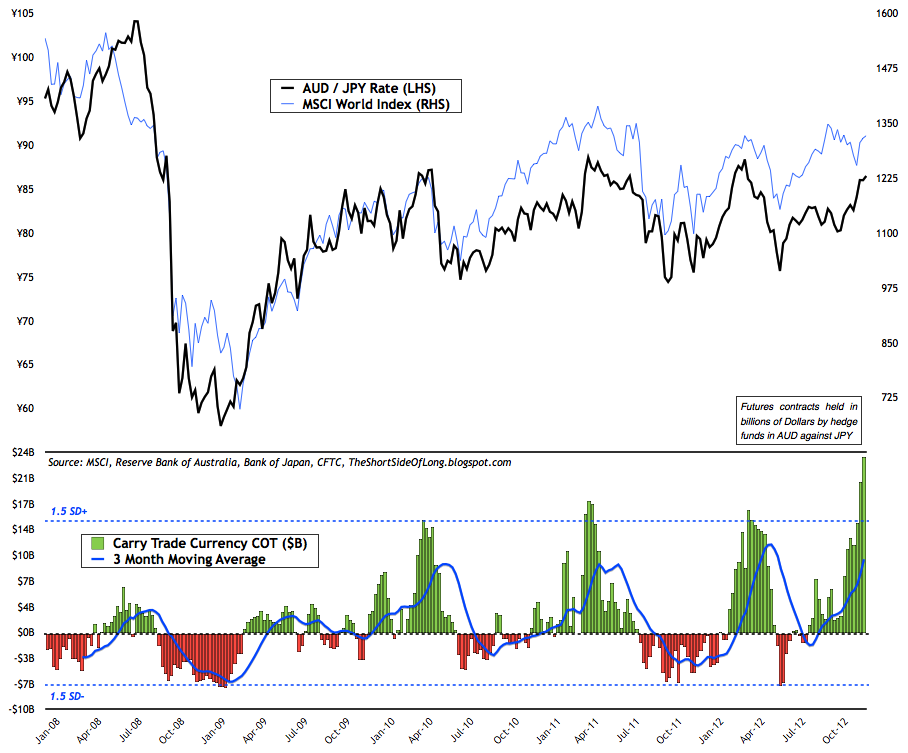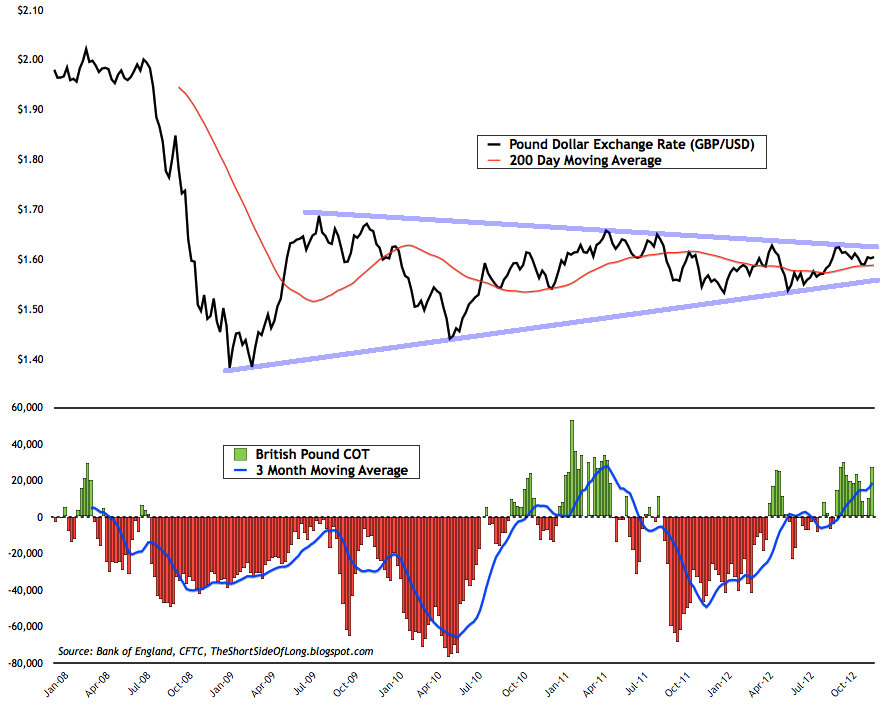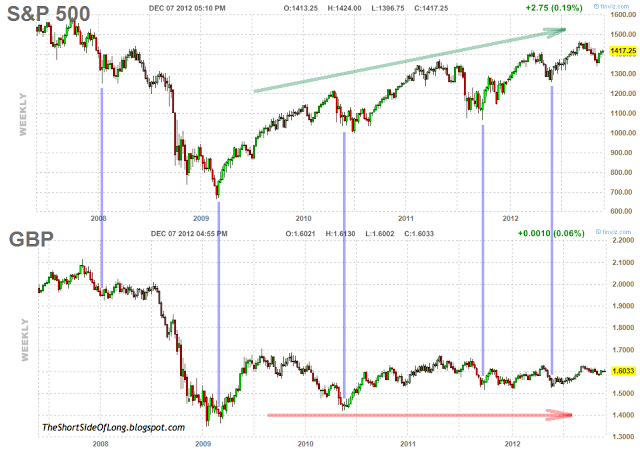Cross posted from The Short Side Of Long blog by Tiho Brkan, discussing price movements of different asset classes, from stocks to bonds, currencies to commodities and everything else in between, including a bit of alternative assets at times as well.
My last post covered the QE4 rumours in circulation, so today I thought I’d gauge the sentiment and positioning of market participants within the currency market before Ben Bernanke and the league of extraordinary central banking gentlemen take stage for one last FOMC meeting for 2012.
Let me just say straight up that this meeting is not as important as some have made it out to be. In all honesty, regardless of whether the Fed starts further easing this week or sometime in early 2013 is absolutely irrelevant to the markets, as they tend to be a discount mechanism. From what we know, the FOMC board of voting members looks super-dovish next year, with cheer-leading money printer Charles Evans joining the voting ranks together with his side-kick Eric Rosengren. It shouldn’t be too difficult to figure out what the consensus of the Fed’s game plan will look like next year, with Mr Evans and Mr Rosengren recently giving us some hints.
Teaming these two new money printers together with some permanent super-doves like Ben Bernanke, William Dudley & Janet Yellen, and you are sure to get at least up to QE 6 by next year’s end. Whether or not these policies will work in pushing up stock and real estate prices remains to be seen, but one thing is for sure – it will definitely cause some serious volatility in the currency markets.
According to the Nomura currency research team, measuring implied volatility on risky currencies such as the Korean Won, Brazilian Real, Turkish Lira, Mexican Peso, Aussie Dollar, South African Rand amongst others is now lower and at more complacent levels than at any other time since at least 2008. Furthermore, currencies like the Mexican Peso and Aussie Dollar hold very high correlation to markets such as the S&P 500, Junk Bonds, Crude Oil, Copper and other “risk on” assets. With volatility so low, let us look at market positioning next.
Since the majority of currencies trade first and foremost against the global reserve known as the US Dollar, I always like to start by looking at the overall positioning and sentiment there, before looking at other individual currencies. Looking at the chart above, we can see that market participants were extremely net long the US Dollar around May of this year. You might remember warnings against further Dollar purchases on this blog back around the similar time. What followed was a QE3 sell off and break below the 200 MA for the first time since July of 2011. Now, it seems investors are indecisive on the future trend of the greenback as their positioning is being whipsawed.
Various sentiment indicators, such as Public Opinion, are also quite neutral too. The Dollar’s technical picture has been one of a rising trend channel since the middle of 2011. When the price would retest the resistance of the channel, so would the sentiment and a correction followed. And when the priced would reach the bottom of the channel, so would sentiment and a rally would surprise the majority. Now the Dollar is once again flirting with the support line of the rising channel, but this time around, sentiment is not as bearish as during previous occasions. Can the Dollar rally, despite only neutral sentiment readings, or will we see a break down out of the channel?
I’ll let Ben Bernanke and the league of extraordinary central banking gentlemen decide that one for me:
While the Dollar positioning is not giving us much of an edge (just like many other markets), such low volatility has created a lot of complacency in the markets. One of the side-effects of very small daily price movements is usually seen in the over-bullish positioning of carry traders, those investors who usually bid up higher yielding currencies like the Aussie Dollar while shorting the zero yielders like Japanese Yen.
The chart above shows that this week’s commitment of traders reported an all time record high bullish bet on the Aussie Dollar, while the positioning in the Japanese Yen is third lowest in its history (with small speculators a.k.a. dumb money at record shorts).
Such extreme positioning between risk on currencies like the Aussie and risk off currencies like the Yen, demands attention and definitely warrants caution. The chart above, which I like to call the Carry Trade indicator, shows that current bullish bets on the Aussie Yen has now reached an overly optimistic 2.5 standard deviations away from the mean and since the exchange cross holds very close correlation to the MSCI World Equity Index, what might follow is a serious correction with similarities to April 2010, May 2011 and March 2012.
Supporting a case for a major sell off is the relatively large bullish bet on the British Pound, which remains in one of the tightest trading ranges ever seen – a triangular consolation period for over three years. Of course, bulls will claim that the price will break out on the upside, but I am not so sure of that. First of all, hedge funds are positioned for that outcome, so from a contrarian point of view, I’d rather go the other way.
More importantly, the Pound is also highly correlated to the S&P 500, but fundamentally tends to move in its own direction over the longer term. We can see in the chart above that the S&P 500 and the British Pound tend to bottom at just about the same time post corrections. Therefore, one can say that the Pound has had its chance to rally since the March 2009 low and has failed to do so. The last highs were made in 2009 and then again in 2011.
Now that the equity markets are overbought and the bull market is aged with the global economy slowing down, I am afraid that Pound bulls might be disappointed. If and when the equity market turns down, with the risk off trade dominating the overall conditions, the Pound will most likely be punished with a move back towards the March 2009 lows.
The currency market seems to be stuck between a rock and a hard place. On one side we have dovish Fed members, who are surely eager and willing to print more US Dollars to postpone a recession and re-spark some type of economic activity. This tends to be a bearish outcome for the King Dollar and benefits the risk on / inflation trade to some degree. On the other hand, we have extremely complacent volatility with very heavy positioning on either side of the spectrum in both the Aussie and the Yen. Historically, this type of extreme positioning always tends to be mean reverting and could therefore risk asset signal selling directly ahead.
The market will decide soon enough.
